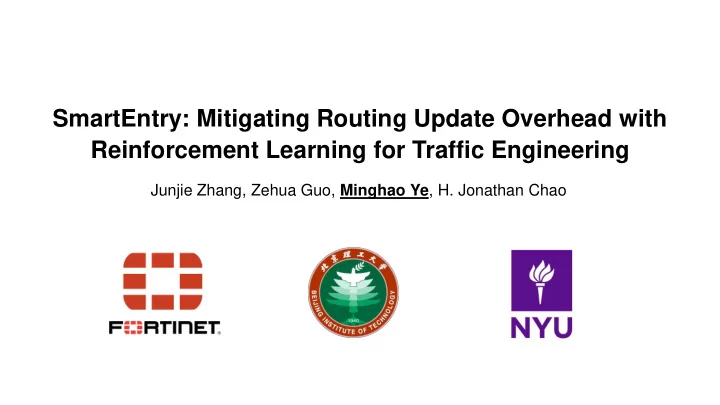

SmartEntry: Mitigating Routing Update Overhead with Reinforcement Learning for Traffic Engineering Junjie Zhang, Zehua Guo, Minghao Ye , H. Jonathan Chao
Background ➢ Traffic Engineering (TE): Configure routing to improve network performance Load ➢ Metric: Maximum Link Utilization (MLU) → Capacity of the most congested link 2
Background ➢ Traffic Engineering (TE): Configure routing to improve network performance Load ➢ Metric: Maximum Link Utilization (MLU) → Capacity of the most congested link Congested! 2
Background ➢ Traffic Engineering (TE): Configure routing to improve network performance Load ➢ Metric: Maximum Link Utilization (MLU) → Capacity of the most congested link Congested! 2
Flow-based or Destination-based Routing? Flow-based Routing Destination-based Routing 6 7 6 7 1 8 5 1 8 5 2 4 2 4 3 3 Flow table at node 5 Forwarding table at node 5 Match Action Destination Next Hop src = 2, dst = 7 Fwd to 6 7 6 src = 4, dst = 7 Fwd to 8 Paths from two different sources to same Two different sources can reach the same destination must coincide once they overlap destination with different preconfigured paths ➢ Lower forwarding complexity - 𝑃 𝑄 entries Fine-grained traffic distribution control ➢ Widely implemented with simple RAMs 𝑄 = # of IP routes Need to store 𝑃(𝑄 2 ) flow entries! Centralized controller can be applied to update Scalability issue with limited TCAM resource the entries when traffic changes 3
Motivation However, traditional TE need to update all entries to improve network performance! Take considerable time → cannot react to traffic changes in a responsive manner Q: Can we mitigate routing update overhead? A: Differentiate and route flows with a new traffic abstraction! (1) Only update some critical entries at some critical nodes to reroute traffic (2) The remaining unaffected traffic are forwarded by ECMP Equal-Cost Multipath (ECMP) Bottleneck 4
Motivation However, traditional TE need to update all entries to improve network performance! Take considerable time → cannot react to traffic changes in a responsive manner Q: Can we mitigate routing update overhead? A: Differentiate and route flows with a new traffic abstraction! (1) Only update some critical entries at some critical nodes to reroute traffic Forwarding table at node 1 (2) The remaining unaffected traffic are forwarded by ECMP Destination Next Hop 6 2 (100%) Update Critical Entries Critical Entries 4
Motivation However, traditional TE need to update all entries to improve network performance! Take considerable time → cannot react to traffic changes in a responsive manner Key Problem: which pairs are ‘critical’? Q: Can we mitigate routing update overhead? There are too many (node, dst) combinations! A: Differentiate and route flows with a new traffic abstraction! (1) Only update some critical entries at some critical nodes to reroute traffic Forwarding table at node 1 (2) The remaining unaffected traffic are forwarded by ECMP Destination Next Hop 6 2 (100%) Update Critical Entries Critical Forwarding table at node 3 Entries Destination Next Hop 10 5 (100%) Forwarding table at node 5 Destination Next Hop 10 7 (33.3%), 8 (66.6%) Updated with reduced MLU! 4
SmartEntry: RL + LP combined approach Idea: (1) Using Reinforcement Learning (RL) to smartly select critical pairs for routing update (2) Solve a Linear Programming (LP) optimization problem to obtain destination-based routing solution Reward: 1/MLU (for training) (3) Solve a LP optimization (2) Action: Select 𝐿 problem to obtain destination- (node, dst) pairs for based routing solution Critical pairs routing update (4) Update the traffic split Only for online ratios for critical entries at (1) Collect the state: deployment critical nodes Traffic Matrix Environment: Network 5
Why is RL + LP powerful? ➢ RL can model complex selection policies as neural networks to map “raw” observations to actions ➢ LP generates reward signal for RL to learn a better combination selection policy (minimize MLU) Gradient update Produce reward signal RL : Actor-Critic Architecture N * (N-1) LP outputs Input state Actions Expected reward 6
Experiment setup ➢ We use 4 real networks to evaluate SmartEntry ➢ Baseline Methods ❖ ECMP: Distributes traffic evenly among available next hops along the shortest paths ❖ Weighted ECMP: extends ECMP to allow weighted traffic splitting with shortest paths ➢ Evaluation Metric: Performance Ratio (PR) ❖ Compare against optimal flow-based routing in terms of MLU ❖ 𝑸𝑺 = 𝑵𝑴𝑽 𝒑𝒒𝒖𝒋𝒏𝒃𝒎 /𝑵𝑴𝑽 𝑻𝒏𝒃𝒔𝒖𝑭𝒐𝒖𝒔𝒛 Optimal Routing SmartEntry MLU = 18% MLU = 20% 𝑸𝑺 = 𝟐𝟗% 𝟑𝟏% = 𝟏. 𝟘 7
Number of critical entries ➢ SmartEntry achieves near-optimal performance with only 10% entries updated 8
Comparison in different networks ➢ SmartEntry performs consistently well on real and synthesized traffic matrices 9
Generalization test ➢ Training on week 1, test on week 2 ➢ SmartEntry generalizes well to unseen traffics Abilene Network GÉANT Network 10
Conclusion ➢ With an objective of minimizing maximum link utilization in a network and mitigating routing update overhead, we proposed SmartEntry, a scheme that learns a combination selection policy automatically using reinforcement learning, without any domain specific rule-based heuristic. ➢ SmartEntry smartly selects a combination of 𝐿 node-destination pairs for each given traffic matrix and reroutes the selected traffic to achieve load balancing of the network by solving a rerouting optimization problem. ➢ Extensive evaluations show that SmartEntry achieves near-optimal performance and generalizes well to traffic matrices for which it was not explicitly trained. 11
Recommend
More recommend